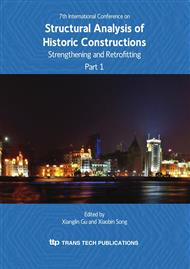p.815
p.821
p.831
p.837
p.843
p.849
p.855
p.861
p.867
Seismic Risk Mitigation of Historical Masonry Towers by Means of Prestressing Devices
Abstract:
This work presents the investigation of the efficiency of different prestressing devices as a rehabilitation measure for the seismic risk mitigation of historical masonry towers. As a first phase, the seismic vulnerability of theoretical masonry towers was assessed by means of numerical models validated with information from the literature, observed damage and behavior of these structures due to passed earthquakes (crack pattern and failure mechanisms), and mainly taking into account the engineering experience. Afterwards, the validated models were rehabilitated with different prestressing devices; analyzing the results and concluding which device or the combination of them improved in a better way the seismic performance of the masonry towers. Finally, the methodology will be applied in two historical masonry towers located in seismic areas; the medieval tower “Torre Grossa” of San Gimignano, Italy, and one of the bell towers of the Cathedral of Colima, Mexico.
Info:
Periodical:
Pages:
843-848
Citation:
Online since:
October 2010
Price:
Сopyright:
© 2010 Trans Tech Publications Ltd. All Rights Reserved
Share:
Citation:


